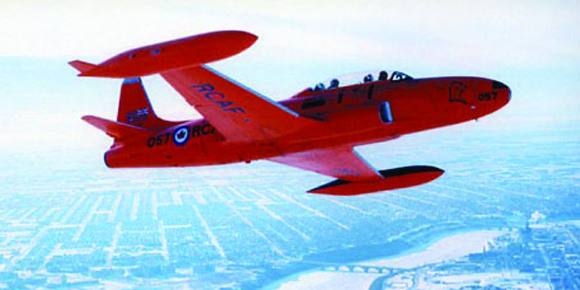by Bruce Cherney (part 1)
The Heritage Highlight below falls under the category: “I was there. I saw it happen.”
“It” happened on August 21, 1963, when the annual Gimli Air Force Day was in full flight at the Royal Canadian Air Force (RCAF) base four kilometres directly west of the lakeside community. As a young lad, I was thrilled that I was among the 2,500 spectators, witnessing the death-defying feats of the aerobatics teams featured that afternoon.
With each pass by of an aircraft and the completion of a figure eight or some other aerobatic display, the crowd, with feet firmly planted on the ground, would erupt in applause. The daring pilots and their machines passed so closely to the audience that the roar of either piston-driven or jet engines reverberated with such force that sound waves seemed to penetrate the chest cavities of spectators, momentarily taking away their ability to breath effectively. The above-ground manipulation of their machines by the flyers was truly awe-inspiring.
That was the point of the aerobatics — give the people plenty of thrills. Screams of delight arose among the younger people in the audience, including myself, with each roll-over performed. It was truly magical how the pilots operated their craft while travelling through the sky. It all seemed so effortless, although that was far from the case.
The Lake Centre News of August 16, 1963, gave the line-up for Gimli Air Force Day as featuring the “world-famous Golden Hawks ... the Moose Jaw Formation Team flying Harvards (a propellor-driven trainer), the Red Knights from RCAF Station Portage (la Prairie) and the precision formation team of Gimli, The Smokers, flying T-33 jet aircraft.”
There was also a static display of aircraft used for flight training by the RCAF, including the Chipmunk, Harvard, Expiditor and the T-33 Silver Star. (This designation was used for the Canadian version of the T-33 manufactured under a 1951 licence from Lockheed in the U.S. by Canadair. The U.S. version manufactured by Lockheed was called the T-33 Shooting Star and first flew in 1948.)
Until “it” happened, no one was disappointed by what they saw on the ground and in the air.
The Red Knights were a duo of RCAF pilots who flew brilliant red-painted T-33 Silver Star single-engine jets. The colour applied to the jet’s airframe was ordinarily used for painting wing-tip fuel tanks used on the T-33s. Later, a knight’s helmet was stenciled in black on each side of the Red Knight aircraft.
Flight-Lieutenant J.W. “Bud” Morin and Flight-Lieutenant Wayne MacLellan of the Red Knights were noted for performing their stunts within close distance of spectators.
A press release issued by RCAL officials prior to the show stated: “A unique feature of the Red Knight’s show is that all manoeuvres are carried out within the confines of the airfield — a most difficult task with a high-speed aircraft.”
What was unusual on that day in Gimli was that there were two Red Knights in the air at once. Normally, one Red Knight pilot would be performing a solo routine at one air show, while the second Red Knight pilot was performing in an air show in another part of the country. In fact, the aerobatic display was originally a solo act when it began in 1958, but in 1961 a second Red Knight and an alternate pilot were put into service.
“It” happened about half a kilometre from the audience and two-thirds through the 20-minute Red Knights’ display when both pilots were performing a “Cuban 8,” a figure-eight aerobatic manoeuvre that also involves intricate rolls and loops.
MacLellan realized he was too close to the ground and aborted his portion of the Cuban 8, pulling on the controls to manoeuvre skyward and out of harm’s way.
I watched in disbelief as Morin’s plane hit the runway, bounced into the air once and then again before exploding. At that point, the only thing visible was a rolling red, yellow and orange fireball. Nothing resembling an aircraft could be seen, as if it had disintegrated.
Morin had completed the final roll of the Cuban 8 and during the pull through contacted the ground.
I was too young to fully comprehend what I had just witnessed, but I knew the fireball wasn’t part of the show and that it probably had deadly consequences for the pilot.
As it turned out, debris from the T-33 was scattered across the airfield and most of the pieces were less than two-feet square, according to a report by Fred Cleverley in the August 22, 1963, Winnipeg Free Press. Part of the debris field included Morin’s unused parachute and ejector seat.
“Officials said the pilot made no attempt to use his parachute,” wrote Cleverley.
“The air show continued after the crash. The last act of the show featuring the Golden Hawks was already in the air at the time of the crash. Officials had decided to continue with the show rather than halt the aerial display.”
Ethel Howard, a reporter for the Lake Centre News, also watched as the airplane smacked into the ground. In her account, published on August 23, she wrote that the announcer in the control tower “calmly told the sickened spectators that the show would go on. The crowd stayed on, but few had any heart to thrill at the daring formations of the Golden Hawks, who brought the afternoon performance to close at 4 p.m.”
(Next week: part 2)



